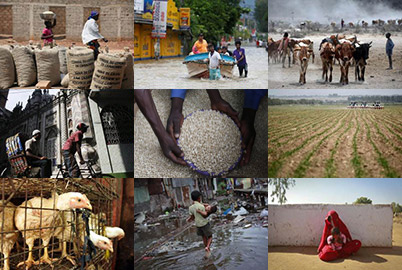OPINION: As drought hits, Zimbabweans are going hungry
But efforts to boost food security, health and nutrition in Zimbabwe’s cities could have a big payoff
Source: OPINION: As drought hits, Zimbabweans are going hungry – Reuters
* Any views expressed in this opinion piece are those of the author and not of Thomson Reuters Foundation.
People in Bulawayo’s townships in Zimbabwe primarily survive on maize. Even so, the year 2019 has hit them particularly hard, with the drought drying up the supply of grain to the city. Prices of staple foods have gone up.
“Many of us know what makes a balanced diet, but we don’t have the means to access those nutritious foods,” says Thembelihle E Ndlovu, a community health worker in Old Pumula township.
Gabriel Banda, a young father, explains, “I eat at home as few times as possible so that the food can go a long way to feed my family.” Many parents are forced to make the same choice, eating just one maize meal a day.
Often, the onus is on the grandparents. “In our home, me, my son and my grandson go many days without food. Often our sadza (maize meal) is only held with water and salt. On better days we have some vegetables, but not very often,” says Belinda Mpanza.
As education takes a backseat to feeding the family, there is an entire generation of school dropouts. “In Old Pumula or Makokoba townships, you’ll notice many children walking around during a school day. They should be at school,” says Dumisani Nyoni, Deputy Director of Agricultural Extension Services.
Adolescents are taking up prostitution and other harmful activities to help feed their families; teenage pregnancies are on the rise. Many of these girls live with their grandparents or look after their siblings as the parents have gone to South Africa in search for employment.
Currently facing hyperinflation at 300% and high food costs (bread prices up by 60%), citizens of Zimbabwe are struggling to stay afloat. Particularly vulnerable are the urban poor.
But a collaborative research program is now on to improve health and nutrition in urban high-density areas such as the above townships.
The United Nations Human Settlement Programme (UN Habitat) projects that by 2050 about 60% of Africans will live in cities. In Zimbabwe, urban poverty has led to one-third of all children under the age of five suffer moderate or severe stunting; half of these children live in urban areas (FNC, 2019). Zimbabweans emigrate in search of greater prosperity elsewhere (IOM report 2018).
Urban malnutrition harms the very fabric of society. What is largely invisible and difficult to measure is the incidence of depression in a large percentage of the population owing to the circumstances.
A deep understanding of people’s food choices is essential but often lacking.
What can be done?
Against this background, scientists at ICRISAT, Zimbabwe, explore approaches for tackling malnutrition through healthier food choices in African cities.
The “Check It” project aims to explore options to improve dietary diversity in urban high-density areas across Eastern and Southern Africa.
Can we get civil society, health workers and the food industry together to ignite a social movement, with clear, comprehensible steps, to give a new meaning of food and nutrition? Can we bring in healthier grains such as sorghum, millets and legumes from rural supply chains and connect them to urban populations through small-scale processing efforts?
Terrence Mugova of Educate says, “The idea is to find an entry point into dialog and exchange with communities, to discover areas of needs that go beyond providing a meal. We need to mobilize people from different backgrounds to provide vulnerable communities with nutritious food.
Busisa Moyo, CEO, United Refineries Limited, says, “We need simple, replicable business models that can engage people and help them access quality foods.”

